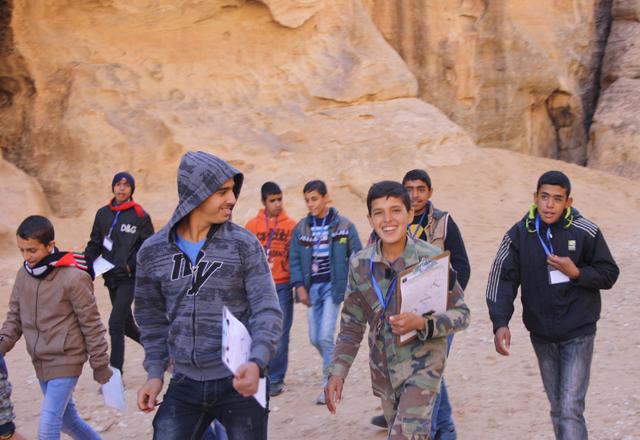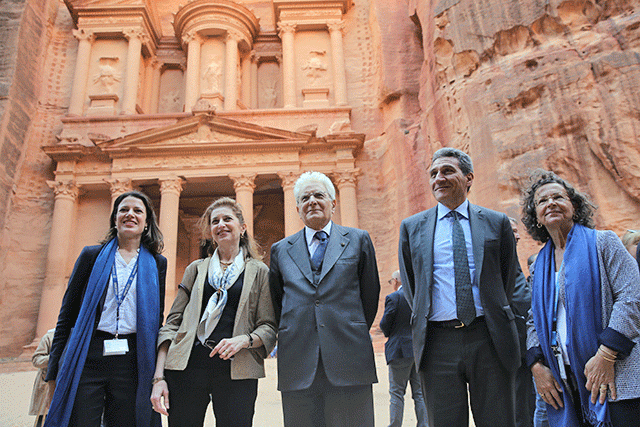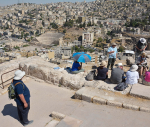You are here
Petra project seeks to preserve ancient city through local youth participation
Apr 03,2017 - Last updated at Apr 03,2017

Students in 'Siq Al Barid', also known as 'Little Petra', exploring the archaeological features that closely resemble the main site at Petra, 235km south of Amman, in Maan Governorate (Photo courtesy of UNESCO)
By Emily Bruser and Giorgia Cesaro
UNESCO
AMMAN — With funding from the Italian government, the UNESCO Amman office is implementing a project to mitigate the hazards of rock falls, earthquakes, floods and weathering in the entrance of the historical city of Petra.
The "Siq Stability" project is being carried out in partnership with the Petra Archeological Park, the Department of Antiquities of Jordan, as well as Jordanian and international experts in the field of landslide risk preparedness and mitigation, with the aim of preserving the site and ensuring the safety of visitors.
The ancient city of Petra was named a UNESCO World Heritage Site in 1985, and is enshrined as one of the Seven Wonders of the World. Today, a core 264 square kilometres, including the site itself, is defined as the strictly regulated Petra Archeological Park.
UNESCO’s Siq Stability project focuses on a critical 30 square kilometres including the 1.2-kilometre-long "Siq", and the two mountain ranges along each side.
The imposing Siq Canyon is the "mouth" of Petra. The rock landmass was split by tectonic forces, revealing a narrow, echoing gap that snakes towards the Treasury.
However, the Siq has been deteriorating over time, with the degradation accelerated by a few millennia of human and environmental factors.
The potential economic value of the site positively impacts the surrounding inhabitants, including those in the six nearby communities.
But there have been struggles.
Concerted conservation and education efforts have been conducted by UNESCO and Petra National Trust (PNT), a non-profit NGO campaigning on the issues of environment, antiquities and the region’s cultural heritage.
Many of these efforts have centred on the children and youth from the six main villages surrounding Petra, as they stand a strong chance of becoming ambassadors for the protection of the site.
Important educational programmes are currently under way, one of these being a series of nine workshops aimed at raising awareness of Petra and the UNESCO-led Siq Stability project.
Implemented by PNT, and under UNESCO’s supervision, the programme educates children and youth on the significance of the site, the risks the project is striving to mitigate in the Siq, and the value of protecting Petra.
In total, 150 local youth have been trained through the workshop series. The programme has provided a sense of ownership to the children participating from surrounding villages; they see this as "their" Petra, and are therefore eager to learn more about the geological aspects of the site.
Huda, a participant from the surrounding community of Wadi Musa, described her pride in protecting her country, and sharing what she had been learning with other children her age. “Petra is a part of me” she said, adding “it is the jewel of Jordan, and we need to spread the word.”
During one workshop, students watched a short video on the impact of the Siq Stability project and UNESCO’s efforts to safeguard the Siq from natural degradation over the past seven years.
The students learned about current efforts to mitigate risks for tourists and the local community in the Siq, including the prevention of rock falls. The workshop session moved on to discuss rock formation, with the teachers handing out rock samples of the same iron-laden sandstone that is slowly crumbling in the Siq.
The workshop participants discussed the varying types of rocks, learned about erosion and the layers of the stone, and set out to create their own rocks. They began by using layers of colourful sand mixed with plaster and added water.
By the time the students returned from their exploration of the "Siq Al Barid", which is also known as “Little Petra”, the “rocks” had set, allowing students to peel them from the molds. Beautiful, marbled shapes emerged.
Abrar, 13, was another excited participant. “It is so important for Jordanians to take responsibility for protecting the work of the Nabataeans,” she said, referring to the ancient population who migrated out of the arid desert to the more temperate, well-watered Petra as early as the sixth century.
“They did good work!” Abrar exclaimed. Explaining her dream of becoming a paediatrician when she grows up, she said she is eager to spread the word that people need to “protect Petra like they protect their bodies”.
Related Articles
AMMAN —The "Siq Stability" project has been shortlisted among 14 projects to win ICCROM-ATHAR Regional Conservation Centre Award, the Jordan
PETRA — Italian President Sergio Mattarella toured the ancient city of Petra on Thursday before concluding his official visit to Jordan.The
AMMAN — UNESCO on Tuesday launched the second phase of the project “SIQ STABILITY — Mitigation of Immediate Hazards in the Siq of Petra” at

















